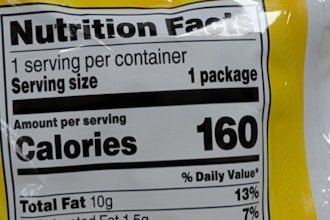The Obama-era updates for nutrition facts labels on packaged foods has been delayed by the Food & Drug Administration (FDA), after industry groups complained to not have enough time to implement the required changes. The FDA has issued a proposed rule to extend the compliance dates for the Nutrition Facts and Supplement Facts label final rule and the Serving Size final rule from July 2018 to January 2020 and 2021. It is important to note that the FDA is not proposing any other changes to the final rules and that only compliance deadlines are modified.
The compliance deadlines will depend on a manufacturer’s annual food sales. Manufacturers with $10 million or more in sales will have until January 1, 2020. Those with annual food sales of less than $10 million will have an additional year to comply with the final rules — until Jan. 1, 2021. This extra time will allow manufacturers covered by the rule to complete and print new nutrition facts labels. Some professionals applauded this extension, such as Pamela G. Bailey, Grocery Manufacturers Association president and CEO, who said that the “FDA’s common-sense decision will reduce consumer confusion and costs.” She also added that the new deadline would give companies more time to follow final guidance documents from FDA which were not released at that time — such as the guidance on fiber and several other key issues only released on March 1, 2018.
However, some companies did not wait to implement the required changes, such as Kind Snacks. According to Justin Mervis, senior vice-president and general counsel: “last year we began updating our labels with the new Nutrition Facts panel and also published the added sugar content for all Kind snacks on our web site. We anticipate completing our label updates by spring 2018 despite any delays to the compliance date for the Nutrition Facts label final rules.”
Ultimately, the new label format will help consumers to better understand what they actually eat. As explained by Michelle Obama, who championed this new guideline. “Our guiding principle here is very simple: that you as a parent and a consumer should be able to walk into your local grocery store, pick up an item off the shelf, and be able to tell whether it’s good for your family.” Indeed, the purpose of these changes is to tackle health conditions related to food consumption such as obesity and heart disease.
Key Changes of the Final Nutrition Fact Label
A Refreshed Label Design
The changes on the look of the label focus mainly on the format of some information, such as:
- Increase type size of “Calories”, “servings per container” and “Serving size”
- Bold the number of calories and “Serving size” declaration
Label should mention the actual amount of vitamin D, calcium, iron and potassium, in addition to the percent Daily Value. Regarding the other vitamins and minerals, manufacturers can declare them on a voluntary basis.
Some existing information will be rephrased so consumers will have a better understanding of what it really means. For instance, the footnote will read: “*The % Daily Value tells you how much a nutrient in a serving of food contributes to a daily diet. 2,000 calories a day is used for general nutrition advice.”
Updated Nutrition Science Information
The nutrition facts label needs to include “Added sugars” in grams and as a percent Daily Value.
Some nutrients including Vitamin D, potassium, calcium and iron are required to be declared. On the other hand, manufacturers can decide whether other nutrients, such as Vitamin A and C, need to be included.
Based on newer scientific evidence, the FDA has reviewed daily values of nutrients especially regarding sodium, dietary fiber and vitamin D. Thus, people are able to understand their nutrition information considering their total daily diet.
Updated Serving and Packaging Sizes
Serving size will correspond to what people effectively eat and not what people should eat, portions have been re-thought. The infographic above shows real portions consumed by people in the US.
“Per Serving”/“Per Package” — On current packages, calories and nutrition information are showed “per serving” only. However, for larger than a single serving products, the new nutrition fact labels requires to add a “per package”/”per unit” column. This aims to better inform consumers about their food and beverage consumption.
Therefore, manufacturers, you have until Jan. 2020 or Jan 2021 — depending on your annual food sales — to comply with the new nutrition facts label. In the meantime, find out how Lascom can help you manage and automatically generate compliant nutrition fact panels, while supporting your product development.
About Lascom
For nearly 30 years, Lascom Product Lifecycle Management (PLM) software has supported the Food & Beverage manufacturers and retailers with their product development. Lascom solution offers a modular software that facilitates decision-making, streamlines new product development and speeds up time-to-market, while enhancing collaboration across each department, from marketing, R&D, quality to compliance. Lascom is the essential partner for the Food & Beverage industry. www.lascom.com






















